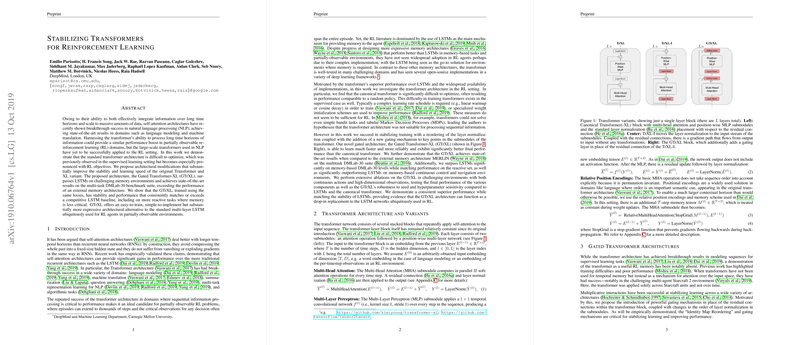An Examination of "Stabilizing Transformers for Reinforcement Learning"
The paper "Stabilizing Transformers for Reinforcement Learning" by Emilio Parisotto et al. addresses the challenges of optimizing transformers in reinforcement learning (RL) settings. Historically, transformers have demonstrated superior performance in NLP tasks due to their ability to process long-sequenced data without vanishing gradient issues. However, this paper explores the difficulties encountered when applying them directly to RL, highlighting the lack of success when using such architectures in environments requiring partially observable settings.
Transformer Architecture in RL
The authors underscore that the typical transformer architecture struggles in RL due to optimization difficulties that are exacerbated compared to supervised learning tasks. In an RL context, these challenges manifest so prominently that the resulting policies often perform no better than a random policy. Training prescriptions for transformers in supervised settings, such as implementing complex learning rate schedules and specific initialization schemes, prove insufficient in addressing these intrinsic issues in RL tasks.
Introducing Gated Transformer-XL (GTrXL)
To overcome these challenges, the authors propose the Gated Transformer-XL (GTrXL), an architectural variant that builds upon the Transformer-XL design. The GTrXL introduces several key modifications:
- Identity Map Reordering: This adjustment involves reshuffling layer normalization placements so that they operate solely on submodule inputs. This change conserves an identity path from layer input to output, akin to the benefits seen with residual networks in facilitating optimization in very deep architectures.
- Gating Mechanisms: Rather than using standard residual connections, the GTrXL embeds gating layers at critical points within the architecture. These gates, inspired by mechanisms like those found in GRUs and LSTMs, are implemented to enhance expressiveness and stabilize training by gating both inputs and updates in key transformer submodules.
Experimental Validation
The paper provides thorough experimentation across various benchmarks to substantiate the proposed architectural modifications. GTrXL surpassed traditional LSTMs in memory-dependent RL tasks, demonstrating compelling results across the DMLab-30 benchmark, a suite encompassing both reactive and memory-intensive challenges. The results notably indicate that, in memory-centric environments, GTrXL achieved state-of-the-art performance, exhibiting significant learning speed improvements and demonstrating enhanced robustness across different seeds and hyperparameter fluctuations.
Additionally, the work highlights a key benefit of the GTrXL in scaling with the size of the problem. Unlike LSTMs that degrade as sequence lengths increase, the GTrXL maintains superior performance, supporting its potential for addressing large-horizon environments typical in RL tasks.
Implications and Future Directions
The results reported by Parisotto et al. have important implications both theoretically and practically. Theoretically, the modifications introduced by GTrXL affirm the critical role of gating and normalization strategies in deep architectures, elucidating a path for future research in ameliorating optimization barriers in RL. Practically, the higher performance stability and expressiveness of GTrXL can be leveraged in RL tasks where memory usage is crucial for optimal decision making.
Looking forward, one could speculate that scaling GTrXL further could yield even more powerful models capable of tackling more complex environments and potentially combining this approach with advances in hierarchical RL and meta-learning. Given the modularity of the transformer's design, future exploration might include variations that combine GTrXL with other architectural innovations or integrate more sophisticated reinforcement learning paradigms adapting deeper insights from NLP.
Overall, this paper presents a substantial contribution by successfully adapting transformer architectures for reinforcement learning tasks, paving the way for more effective and scalable RL solutions.
